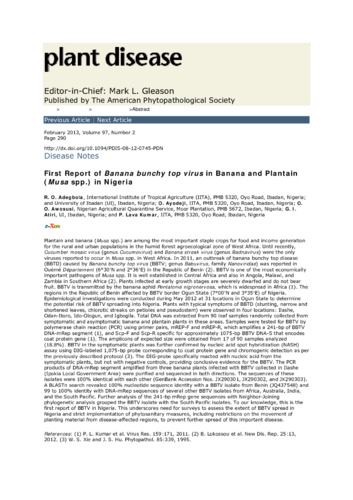First report of banana bunchy top virus in banana and plantain (musa spp.) in Nigeria (ABSTRACT)
Abstract
Plantain and banana (Musa spp.) are among the most important staple crops for food and income generationfor the rural and urban populations in the humid forest agroecological zone of West Africa. Until recently,Cucumber mosaic virus (genus Cucumovirus) and Banana streak virus (genus Badnavirus) were the onlyviruses reported to occur in Musa spp. in West Africa. In 2011, an outbreak of banana bunchy top disease(BBTD) caused by Banana bunchy top virus (BBTV; genus Babuvirus, family Nanoviridae) was reported inOuémé Département (6°30′N and 2°36′E) in the Republic of Benin (2). BBTV is one of the most economicallyimportant pathogens of Musa spp. It is well established in Central Africa and also in Angola, Malawi, andZambia in Southern Africa (2). Plants infected at early growth stages are severely dwarfed and do not bearfruit. BBTV is transmitted by the banana aphid Pentalonia nigronervosa, which is widespread in Africa (1). Theregions in the Republic of Benin affected by BBTV border Ogun State (7°00′N and 3°35′E) of Nigeria.Epidemiological investigations were conducted during May 2012 at 31 locations in Ogun State to determinethe potential risk of BBTV spreading into Nigeria. Plants with typical symptoms of BBTD (stunting, narrow andshortened leaves, chlorotic streaks on petioles and pseudostem) were observed in four locations: Ilashe,Odan-Itoro, Ido-Ologun, and Igbogila. Total DNA was extracted from 90 leaf samples randomly collected fromsymptomatic and asymptomatic banana and plantain plants in these areas. Samples were tested for BBTV bypolymerase chain reaction (PCR) using primer pairs, mREP-F and mREP-R, which amplifies a 241-bp of BBTVDNA-mRep segment (1), and Scp-F and Scp-R specific for approximately 1075-bp BBTV DNA-S that encodescoat protein gene (1). The amplicons of expected size were obtained from 17 of 90 samples analyzed(18.8%). BBTV in the symptomatic plants was further confirmed by nucleic acid spot hybridization (NASH)assay using DIG-labeled 1,075-bp probe corresponding to coat protein gene and chromogenic detection as perthe previously described protocol (3). The DIG-probe specifically reacted with nucleic acid from thesymptomatic plants, but not with negative controls, providing conclusive evidence for the BBTV. The PCRproducts of DNA-mRep segment amplified from three banana plants infected with BBTV collected in Ilashe(Ipokia Local Government Area) were purified and sequenced in both directions. The sequences of theseisolates were 100% identical with each other (GenBank Accession Nos. JX290301, JX290302, and JX290303).A BLASTn search revealed 100% nucleotide sequence identity with a BBTV isolate from Benin (JQ437548) and99 to 100% identity with DNA-mRep sequences of several other BBTV isolates from Africa, Australia, India,and the South Pacific. Further analysis of the 241-bp mRep gene sequences with Neighbor-Joiningphylogenetic analysis grouped the BBTV isolate with the South Pacific isolates. To our knowledge, this is thefirst report of BBTV in Nigeria. This underscores need for surveys to assess the extent of BBTV spread inNigeria and strict implementation of phytosanitary measures, including restrictions on the movement ofplanting material from disease-affected regions, to prevent further spread of this important disease.

